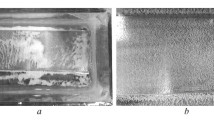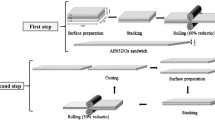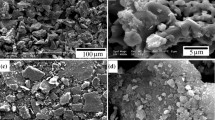Abstract
Roll bonding is the most important stage of the accumulative roll bonding process, which is used to produce high strength composites. The presence of a particle layer at the interface alters the bonding condition and increases the threshold reduction for the commencement of bonding. In this study, the bonding mechanism in presence of powder at the interface is analyzed and a theoretical model is proposed to predict the required threshold reduction in warm roll bonding of commercially pure aluminum sheets as a function of amount of alumina particles at the interface. The model considers the rolling parameters and the effect of amount and size of particles by defining some constants, which are obtained by experiment. It is shown that the measured values of the threshold reduction are very well predicted by the modeling results.
Similar content being viewed by others
References
C. Lu, K. Tieu, and D. Wexler, J. Mater Process. Technol. 209, 4830 (2009).
R. Jamaati and M. R. Toroghinejad, Mater. Sci. Eng. A 527, 4146 (2010).
M. Rezayat, A. Akbarzadeh, and A. Owhadi, Composite A 43, 261 (2012).
M. Alizadeh and M. H. Paydar, J. Alloys. Compd. 492, 231 (2010).
M. Alizadeh and M. H. Paydar, Mater. and Design. 30, 82 (2009).
K. Kitazono, E. Sato, and K. Kuribayashi, Acta. Mater. 50, 495 (2004).
N. Bay, CIRP Annals — Manuf. Technol. 34, 1985 (1985).
Y. Mitani, R. Vargas, and M. Zavala, Thin. Solid. Films. 111, 37 (1984).
H. Mohamed and J. Washburn, Welding Research Supplement 302 (1975).
John M. Parks, Welding Research Supplement 32, 209 (1953).
R. Jamaati and M. R. Toroghinejad, Mater. Sci. Eng. A. 527, 4858 (2010).
J. G. Lenard, Primer on Flat Rolling, pp.36–52, Elsevier, Oxford (2007).
K. Kavakita and K. H. Lüdde, Powder. Technol. 4, 61 (1971).
J. Chakrabarty, Theory of Plasticity, pp.480–497, McGraw-Hill Book Co., Singapore (1987).
W. Zhang and N. Bay, Welding J. 76, 417 (1997).
C. Xie and W. Tong, Acta. Mater. 53, 477 (2005).
H. R. Le, M. P. F. Sutcliffe, P. Z. Wang, and G. T. Burstein, Acta. Mater. 52, 911 (2004).
S. Strijbos, Ceramurgia. Int. 6, 119 (1980).
G. Pintaude, Wear. 255, 55 (2003).
N. E. Jansson, Y. Leterrier, and J. E. Ma, Eng. Frac. Mech. 73, 2614 (2006).
Author information
Authors and Affiliations
Corresponding author
Rights and permissions
About this article
Cite this article
Rezayat, M., Akbarzadeh, A. Theoretical model for evaluating the threshold reduction in roll bonding of Al/Al2O3/Al laminations. Met. Mater. Int. 18, 827–832 (2012). https://doi.org/10.1007/s12540-012-5012-9
Received:
Accepted:
Published:
Issue Date:
DOI: https://doi.org/10.1007/s12540-012-5012-9




